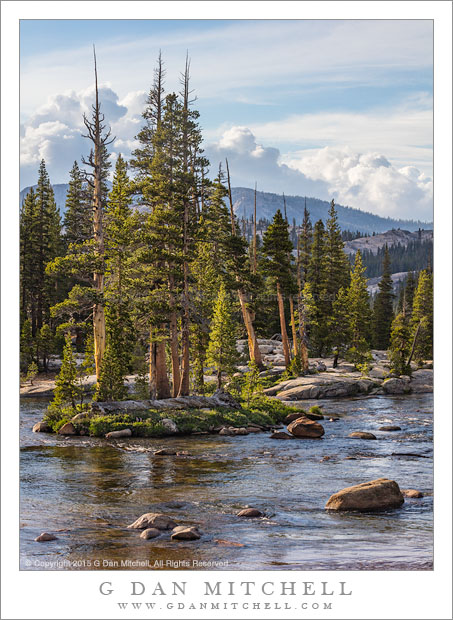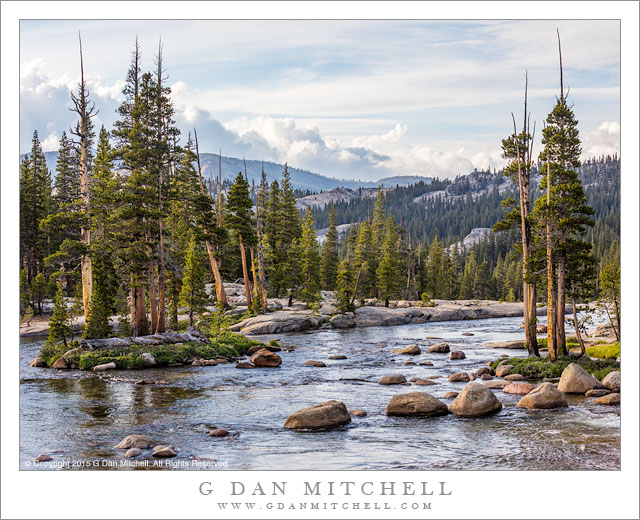(“A Photograph Exposed” is a series exploring some of my photographs in greater detail. A companion article looks at post processing issues related to the same subject.)
Landscape photographs depend on many things: good fortune to be in the right place at the right time, experience that helps predict when and where to find “right place at the right time,” sensitivity and experience that help you recognize the potential in a scene, being able to think beyond the intrinsic beauty of a scene to consideration of how it might make a photograph, an intuitive sense of “what is right” visually, the ability to apply some objective thought on top of the intuition, and other things in a list that is too long to recount completely.
I would like to share some of the thinking that went into photographing one particular scene earlier this summer.

Back in mid-July I experienced a special evening in the Tuolumne Meadows Sierra Nevada of Yosemite National Park. It was special for many reasons — some photographic and some not, but even the non-photographic reasons helped put my mind and my senses in the right place to make photographs. I had arrived and set up camp, taken care of camp chores, and finally headed out for late-afternoon and evening photography. I pulled off the road to take a look at a possible subject, and by remarkable coincidence found myself parked behind two good friends who were there for much the same reason. We joined forces and headed of to a nearby area that seemed promising. In an even more remarkable coincidence, partway there two more friends showed up, also there for the same purpose! Something about hiking off into a beautiful landscape with like-minded friends seems to heighten my awareness.
We followed the Tuolumne River and soon its angle of descent began to increase slightly as its channel narrowed and became more rocky. Before long we arrived at a lovely set of curves in the river’s course where there are large, smooth granite slabs along its banks, open forest comes close to the edges of the water, boulders are scattered here and there, and the landscape is open enough to provide distant views. The granite slab terrain is almost always full of photographic potential, and we stopped here to look for photographs.
I halted at the first granite bowl and I would have photographed it — but one of my friends had already “claimed” that view! I looked around and saw a small tree-covered island in the river with lots of shorter undergrowth, a few rocks, and one fallen snag, and I immediately thought that it was worthy of a photograph.
The first challenge may be to find a thing to photograph, but then the challenge is to figure out how to best photograph it. The answer isn’t always obvious, and more than one solution is possible. My first inclination was to photograph this scene in landscape mode — leading to the photograph shown below:

I partially knew what I wanted to include in the composition, but I also recognized that I had a few problems to work out. My primary subject was to be the tree-covered island, which is on the left side of the frame in this photograph. Because I did not want to cut off the tops of the trees (there are ways that this could have worked, though with a very different effect) the upper boundary of the image was somewhat predetermined. Given some objective limits, a longer than “normal” focal length was in order. (I couldn’t move forward much without ending up in the river, and moving backwards took me uphill, with several problematic results.)
I of course wanted to include the “tree island” on the left, so there was another fixed limit on the composition. They are not visible in the photograph, but other distractions to the left of the trees limited how much I could include on that side. With the tree island necessarily close to the left edge of the frame, the composition seemed unbalanced to me if I didn’t include something on the right side of the frame, so I selected my focal length and framing to include the three trees near the right margin. Fortunately, this left me with just about the right framing along the bottom edge, when I wanted to include the group of small rocks near the lower left, with the line of larger rocks leading across the frame from the trees on the right. I felt that all of this also allowed the river’s path to lead onward into the more distant scene, with the line of the far rocky bank and then on to the distant mountains and the clouds from dissipating afternoon storms.
There were two more challenges to deal with. The first was the large dynamic range. Bright areas included the very bright white clouds in the distance, and potentially a few bright spots on trees or boulders if they were illuminated by unobstructed sunlight. The latter point connected to the second issue. Because of the clouds, the light was continuously changing, ranging between very bright sun and dark cloud-shadows, but with occasional moments of directional sunlight that was slightly muted by clouds — with the latter being just what I needed. So I waited, for quite a while if I remember correctly, until that somewhat soft light came through the edge of some clouds to my left and softly lit the tree island.
With all of that, I knew that this photograph was going to require some work in post-production to bring back some of the darker shaded areas that were going to result from an exposure that protected the highlights of the clouds. So I chose to essentially “under-expose” by comparison to what the camera’s metering system would have done — though I think of it as “correctly exposing” for what I had in mind. My plan would be to bring back the dark areas in post-production and open up the shadows.
So, with all of that taken care of, I waited for the right light to arrive and made my exposure. But, as often happens, now that I had gotten to know the scene a lot better as a result of all of this, I wondered if there might be a better way to approach the composition. The landscape view does, I think, give a sense of open, expansive space — but it also minimizes the presence of what was originally my main subject, the tree island, both by making it small and by introducing more competing elements into the composition. In fact, it seemed just a bit hard to identify a central point of interest in the composition.
Perhaps a vertical (or portrait) orientation might work better? Here is the photograph that resulted from my “second guessing.”

Many of the changes are obvious, but let me go over them. The tree island is more clearly the central element in this vertical composition. The primary subject is much larger and some of those competing elements are now gone, especially the second group of trees that had been at the far right. The positioning of the tree island so close to the left frame edge no longer creates the same sort of imbalance that it did in landscape mode, since the space to the right has also diminished a great deal. The larger scale of the tree island also allows its details to be more visible (especially in a large print), both because they are simply bigger and because there is a bit less competing “busy-ness” elsewhere in the frame.
I had to “give up” that interesting line of rocks in the water of the landscape mode version, but I was able to retain both the group of small rocks in front of the island and the larger rock close to the right edge, and I think that rock may help to balance the weight of the tree island a bit. Because fewer of the background clouds appear in the vertical version, I think that the clouds are more effective and have a more cohesive form. I like the smaller section of the mid-distance granite dome that slants down from the right side — it is enough to maintain the presence of the intermediate ridge and the feeling of recession into the distance, but it competes less with the trees.
In the end, I think I like my second approach a bit more than the first. What do you think?
The Photograph Exposed series:
- A Photograph Exposed: “Submerged Boulders, Lake, and Cliffs” (2010)
- A Photograph Exposed: A Tale of Light (2011)
- A Photograph Exposed: Photography and Luck (2012)
- A Photograph Exposed: “San Francisco Skyline — Winter Fog and Haze” (2015)
- A Photograph Exposed: “Two Rocks, Morning, Racetrack Playa” (2015)
- A Photograph Exposed: “Two Islands, Fog” (2015)
- A Photograph Exposed: “Shoreline Reflections, Trees and Rocks” (2015)
- A Photograph Exposed: One Subject, Two Compositions (2015)
- A Photograph Exposed: Technique and Interpretation in Post (2015)
- A Photograph Exposed: Je Suis Bleu (2022)
 G Dan Mitchell is a California photographer and visual opportunist. His book, “California’s Fall Color: A Photographer’s Guide to Autumn in the Sierra” is available from Heyday Books and Amazon.
G Dan Mitchell is a California photographer and visual opportunist. His book, “California’s Fall Color: A Photographer’s Guide to Autumn in the Sierra” is available from Heyday Books and Amazon.
Blog | About | Flickr | Twitter | Facebook | Google+ | 500px.com | LinkedIn | Email
All media © Copyright G Dan Mitchell and others as indicated. Any use requires advance permission from G Dan Mitchell.
Discover more from G Dan Mitchell Photography
Subscribe to get the latest posts sent to your email.

Dan,
Both are very nice and I agree that on an artistic point the portrait orientation may get a slight edge. Personally I think I would be more inclined to choose the landscape shot. I just love the expansive view of the granite slabs and general wilderness feel of the landscape view based on my personal experiences though my experience is in the Wind Rivers and not the Sierras.
Dan, I probably have to say I like the portrait orientation a bit more as it focuses on the tree island. There is something about it that pops, while the rest of the composition provides just enough reference to place it in the larger context of the environment (hence… the pop). Put another way, it zeroes in on what you originally saw in the frame; what creatively… popped for you while surveying the environment, but still preserves context. One of the specific things I noticed is that you managed to balance elements just enough to preserve a bit of the feeling that the landscape falls away in the midground, allowing the viewer to imagine the river flowing down canyon.
That said, I have to say I also like the landscape oriented shot, although it seems a little more like the embodiment of the John Muir quote… “Climb the mountains and get their good tidings. Nature’s peace will flow into you as sunshine flows into trees. The winds will blow their own freshness into you, and the storms their energy, while cares will drop away from you like the leaves of Autumn.” …if you get what I mean. Gorgeous scene, but full of the expansive goodness of the Sierra.
Thanks for your thoughtful comment, Paul. I think you see the two photographs much the same way that I do. And your reference to Muir is in line with my feeling that the horizontal version, while giving a larger sense of the terrain and the feeling of such places, does not compositionally have the same focus.
Dan